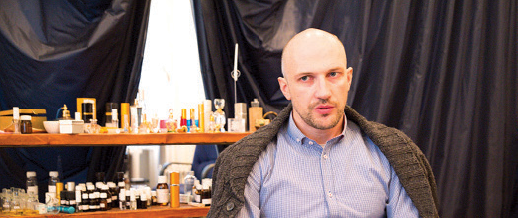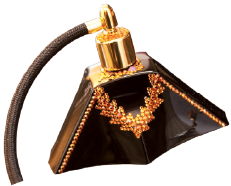By Olga Nefedova
Vlad meets me in his studio, surrounded by flasks of ingredients; a hundred scents fill the air. He studied under the world’s most titled perfumer, Sophia Grojsman, ten years ago, in France, and tells us that Sophia is Belarusian by birth. Speaking of his teacher with great respect, he notes, “She created Lancôme’s best seller Trésor, which matches sales of Chanel No.5. In the USA, Sophia has four honours among 25, on the Avenue of Perfume Glory.

Perfumer Vlad Rekunov in the studio where aromas are born
Vlad boasts two higher education degrees — in engineering and medicine — and creates perfumes with a scientific approach. He first defines the olfactory preferences of a client, discovering their perfumery class on a computer database: scents are divided into about 40 families. Thousands of small ampoules are to be found on the shelves of his studio, ordered in groups. There are tree aromas, vanillas, fruits, mint aromas and those of fresh herbs. There are even scents replicating cream and boiled rice. The most potent are those based on animal aromas: pungent and heavy. Vlad explains, “These animal aphrodisiacs are ‘fixatives’ making perfumes last. They add sensuality and body.”
Once he’s established a client’s preferences, he draws together a base number of components: no more than 50. He then uses his computer to create a unique recipe, before bottling the fragrance. It’s a truly scientific process of measuring and mixing, using special scales fenced by glass, so that no draught of air can influence their indications. The scales are accurate to within a thousandth of a gram.
In his flasks are powders, liquids and solids; some dissolve with simple stirring, while others take more time. He also has a special table-mixer, able to vibrate solutions for 24 hours, and to warm them. Once the perfume has ‘ripened’ — standing for nearly five days — it’s ready for the client’s perusal. Vlad keeps refining until the client is fully satisfied.
 Each perfume formula costs 350 Euros, and takes at least two months to create. Remote orders take more time, since each sample needs to be sent abroad and then returned. Vlad spent about three months on his last commission: a perfume for a bride and groom from Canada, sealed in a unique bottle in the shape of a bee, cast from crystal, with the insect’s eyes clearly defined on each side. The cost amounted to several thousand Dollars.
Each perfume formula costs 350 Euros, and takes at least two months to create. Remote orders take more time, since each sample needs to be sent abroad and then returned. Vlad spent about three months on his last commission: a perfume for a bride and groom from Canada, sealed in a unique bottle in the shape of a bee, cast from crystal, with the insect’s eyes clearly defined on each side. The cost amounted to several thousand Dollars.Naturally, the longer lasting perfumes use higher-quality ingredients, which Vlad buys from abroad. A single bottle may contain components from all over the world: Ethiopian civet, tuberose and ylang-ylang from Asia, sandalwood from Indonesia, and Canadian cedar. He smiles, “Even the names envelop you with a gentle trail of scent.”
Some ingredients, such as Lotus Pink Absolute and lotus oil, cost 50 Euros a gram. Vlad’s arsenal includes a portable perfumery bar, holding several dozen base components. With their help, he creates perfumes on holiday, giving each guest their own unique scent. Most customers are women, although a few men also request a personal fragrance. The head of a small regional firm once invited Vlad to a New Year’s corporate party, where Vlad developed an aroma for each employee. Scents can also be created to represent a certain business or service.
It seems strange that he chooses to base his work in Belarus, since most of his customers are foreigners, but he admits, “Sophia asked me to do all I could for the country; therefore I’m here.”











